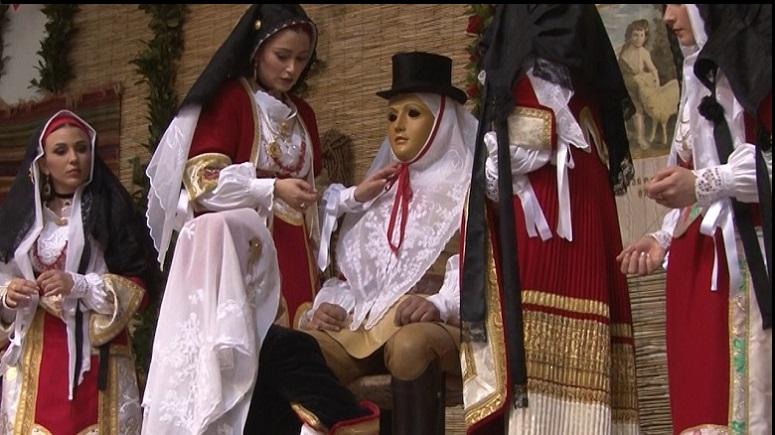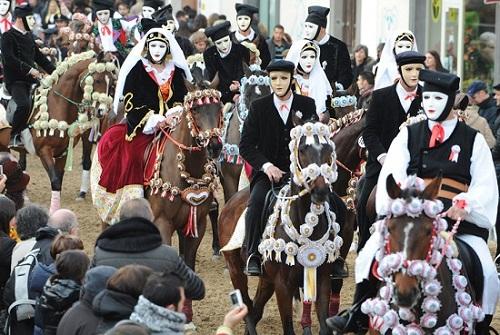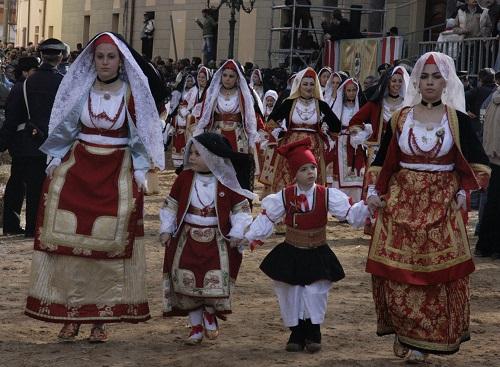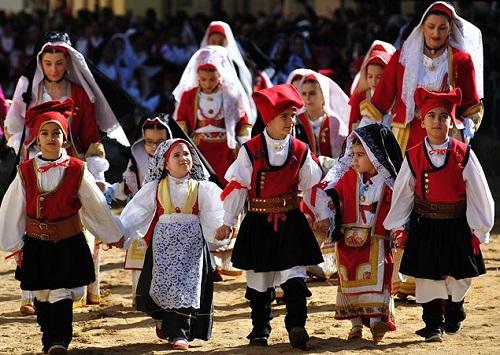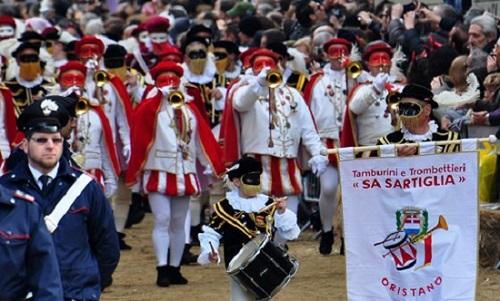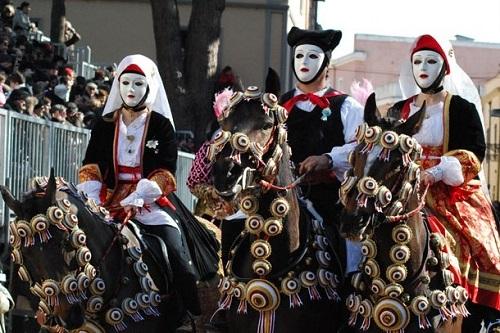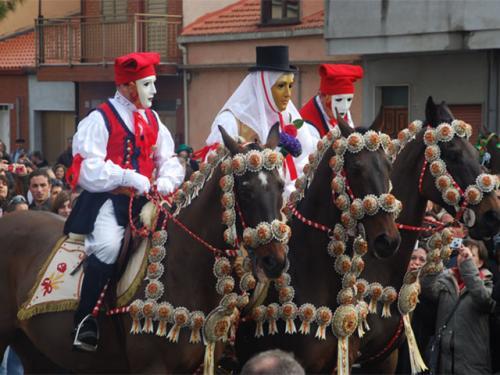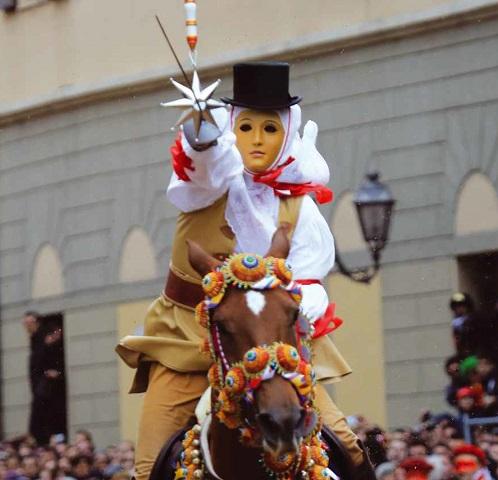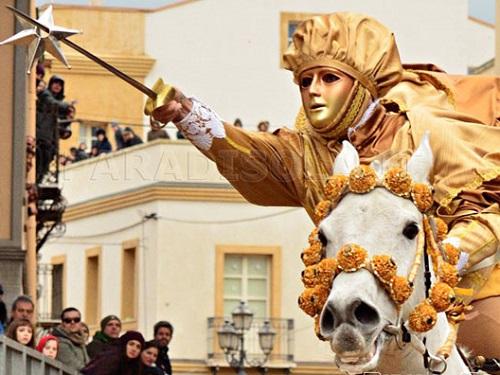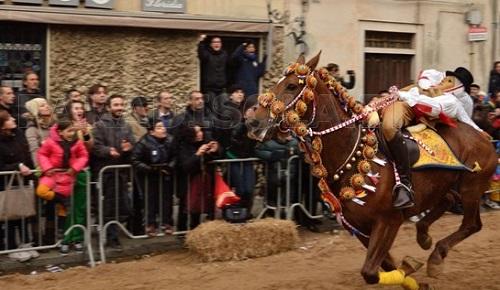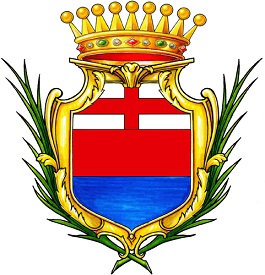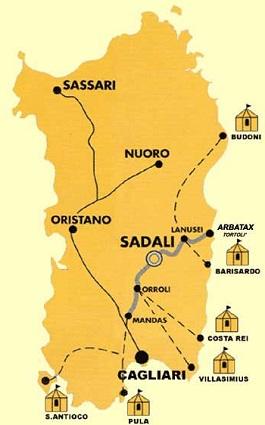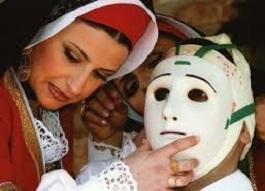|
SA SARTIGLIA -THE EVENT
Is an equestrian masked ride, of clear chivalric origin, held in Oristano, on Sunday and Tuesday of every year at the ending of Carnival . A demonstration rich in charm and symbolism related to the worship of the earth.
Most likely of Saracen origin, was introduced in the western world by the Crusaders between 1118 and 1200
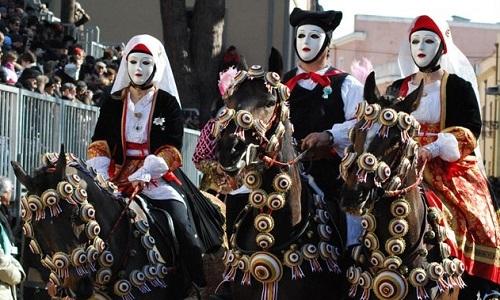
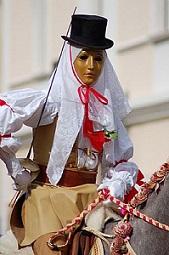
The main figure is "Su Componidori", a horseman/horsewoman, dressed in a fascinating rite to becomes the king or queen of the celebration.
Once the race track has been reached, he declares the joust started, crossing his sword three times with his Second-in-command.
Next, he opens the "riding at the star".
Only the ‘Componidori’ will be entitled to choose, among the horsemen, those who will have the honor to try and spear the star.
As the head race he/she also symbolizes a pagan god/goddess, masculine strength and female fertility together, able to control the rhythms of the seasons, the course of the harvests and the crops.
Still today from the result of the run, from how many stars “taken”, the auspices of good or bad year are drawn.
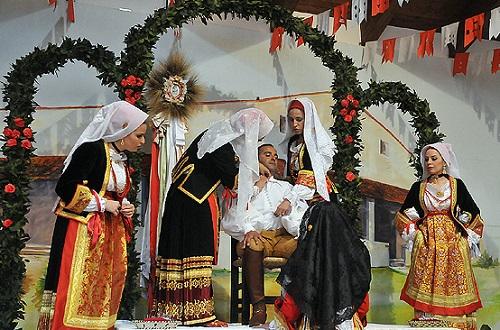 The Componidori is selected according to old traditions by the two local Gremi, the one of Saint Giovanni for the farmers and the one of Saint Giuseppe for the carpenters, also the solely coordinators and tutor of the manifestation.
The investiture takes place during a very intimate ceremony on the day of the Candelora (Feb 2), involving the family and representative of the Gremio.
While the investiture takes place, outside, the masked riders arrive, horses harnessed with hundreds of rosettes lovingly prepared by the women: sisters, girlfriends, wives, mothers that for months have curled kilometers of colored ribbons, sewn on round cardboard bases.
The Procession opens with participants wearing beautiful precious medieval clothes.
Follow the drummers and the trumpeters that precede the procession of the riders in "Pariglia" (pairs of two or three riders),...
...with the Su Componidori riding alongside to "su secundu Cumpoi" and “su terzu Cumpoi”(second and third Componidori).
The long processions unthreads among two wings of a festive crowd, crosses the narrow streets of the city centre and arrives at Mannu square where the ancient castle of Arborea's kings once rose, it then continues on Duomo street lined with thousands of spectators reaching St. Antonio street where the Cathedral is located.
Once the race track has been reached, he declares the joust started, crossing his sword three times with his Second-in-command.
Only the ‘Componidori’ will be entitled to choose, among the horsemen, those who will have the honors to try and spear the star. Next, he opens the riding at the star, Su Componidori is the first one to run followed by the designated riders.
The roll of the drums will accompany the descents to the unbridled gallop, in the difficult attempt to insert the sword in the small perforated star. A roar will explode from the crowd every time the rider will succeed in his/her intent.
Once the joust is over, ‘Su Componidori’ has got a second opportunity to catch the star, this time using a wooden spear (‘stocco’), which he also grants to both his aides-de-camp.
Finally Su Componidori will pass along Duomo street to the unbridled gallop, long reins, laying on his back in a descent (discesa) called “sa remada” while blessing the crowd.
Then, he will guide the cortege to via Mazzini he will give the go ahead to the start of the exhibitions.
Only then will Sa Sartiglia be officially concluded, its rite being definitively assigned to history and to the memory of the whole city.
|
Oristano (Sardinian: Aristanis),is located in the northern part of Campidano plain.
The small city is also the capital of the Province of Oristano, in the central-western part of the island of Sardinia.
In medieval times Oristano vied for power over the whole island of Sardinia, and therefore waged wars against the other Sardinian kingdoms which culminated in the attempt to conquer the whole island during the reign (1347–75) of Mariano IV and that of his daughter Eleanor (1375–1404).
Oristano's history was, characterized by the Aragonese-Spanish (until 1708) and Piedmontese (from 1720) domination, and then the unification of Italy.
THE INVESTITURE
The investiture is a long and complex ritual. An ancient ritual has to be followed in silence, its peak being the head of the tournament's dressing, on the challenge day.
It is a rite full of sacredness: the horseman gets dressed upon a table a real altar adorned with flowers and signs of the feast.
Every step of the ceremony is emphasized according to a strict ritual.
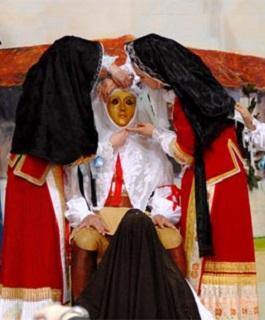
The horseman's dressing is cared for by Massaieddas, young girls wearing a Sardinian costume, directed by an expert woman called Massaia manna.
From this moment on the rider cannot put anymore “foot on the ground”.
When the mask cover her/his face the ritual is completed, the transformation is done.
Once dressed, the king of Sartiglia mounts his horse: he must not to touch the ground until the end of the day.
All the gestures are fast and agitated, the drums roll, then, in a total silence, the horse is brought inside.
Once the dressing is completed, su Cumpoidori crosses the threshold on horseback, wearing a black top hat, a mantiglia, a rich shirt trimmed with lace, a waistcoat, and a broad leather belt.
In his right hand he/she is holding the “scepter” (sa pippia ‘e maiu) a bunch of periwinkle wrapped in a green cloth, onto which a double bunch of violets is inserted, a symbol of spring fecundity, with which , he begins to bless the crowd.
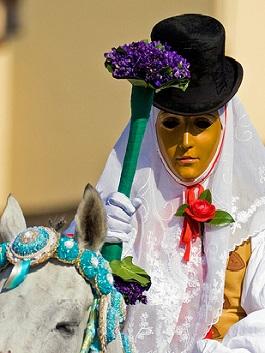
From this moment on,
‘Su Componidori’ is the highest authority charged with the direction of the joust.
The event will be definitely concluded by the ceremony of the undressing.
Approaching ‘sa mesitta’ on horseback, once more taking care not to violate the taboo against touching the ground, he alights directly onto the table where the undressing ritual is about to be fulfilled.
Once the Massaieddas have removed the top hat and the veil, they eventually untie the tapes that have tightened the mysterious mask to the bands around that face for so many hours.
When the mask is pulled off, ‘Su Componidori’ disappears, showing the man’s face to the audience, who can now greet the horseman and praise his achievement.
Sources - Acknowledgement
FONDAZIONE SA SARTIGLIA onlus
Piazza Eleonora d’Arborea
09170 Oristano -Italy
Tel. +39 0783303159 - Fax 1782740952
info@sartiglia.info
|


